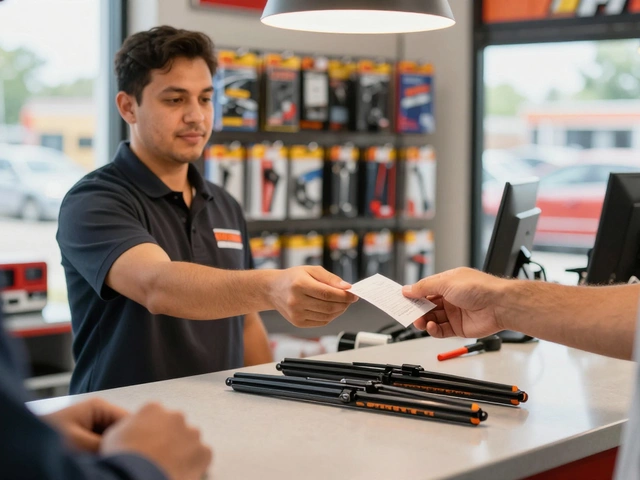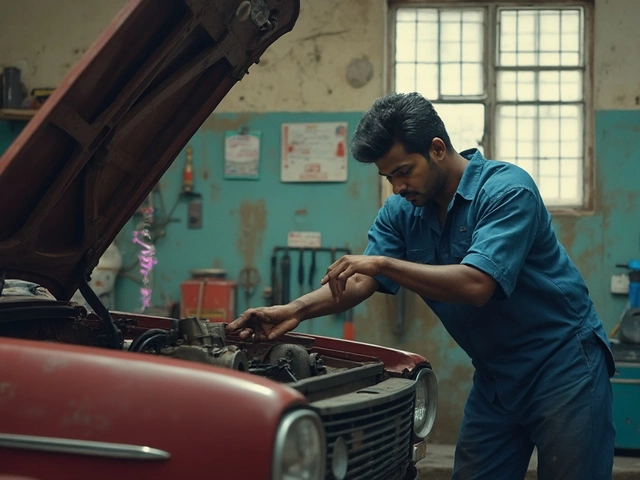Think unplugging your battery will magically fix your fuel pump? You're not alone—this myth has been around for decades. Folks hear the word “reset” and hope all their car’s mysteries vanish when they reconnect the battery terminals. But does that trick really work for your fuel pump? Let’s get straight to what matters.
Your fuel pump isn’t controlled by hocus-pocus. It runs on electrical signals, sure, but the pump’s power comes from its own wiring and the fuel pump relay, not a computer setting that can be wiped out like a phone’s memory. Simply pulling the battery won’t flip some hidden switch on the pump. In most cars—even modern ones—disconnecting and reconnecting the battery may reset your check engine light or zap your radio presets, but it doesn’t magically repair a fuel pump failure or reset the physical parts involved.
- How the Fuel Pump Actually Works
- What Really Happens When You Reset the Battery
- Common Misconceptions: Resetting Isn’t a Magic Fix
- Real Ways to Troubleshoot Fuel Pump Issues
- Smart Tips for Keeping Your Fuel System Healthy
How the Fuel Pump Actually Works
The fuel pump is the muscle behind your car’s fuel system. Its main job? Push fuel from the gas tank up to the engine. Most modern cars use an electric pump located inside the fuel tank, but if you’re driving an old-school ride, it might have a mechanical one bolted to the engine.
When you turn your key to “On,” the pump gets a burst of power from the fuel pump relay. This relay acts like a traffic cop—only letting electricity through when it’s safe. Once powered up, the pump sucks fuel from the tank, runs it through a filter, then shoves it under pressure to fuel injectors or the carburetor. Without enough pressure, your car either stumbles, sputters, or won’t start at all.
If you take a peek at how much pressure the pump generates, most modern systems crank out 40 to 60 PSI (pounds per square inch). That’s enough to drive fuel through long lines and into high-tech injectors without skipping a beat. Here’s a quick comparison if you’re curious how different setups stack up:
| Type | Typical Pressure (PSI) | Location |
|---|---|---|
| Electric (Modern) | 40–60 | Inside tank |
| Mechanical (Older cars) | 4–7 | Engine block |
Most cars these days use an in-tank setup for better cooling and less noise. But don’t get confused—replacing a pump means dropping the tank. Not a fun Saturday project for most people.
Here’s what needs to happen for the fuel pump to do its thing:
- Ignition switch turns ON
- ECU or relay sends voltage to the pump
- Pump draws fuel through a strainer
- Pushes fuel through lines and filter
- Delivers high-pressure fuel to engine
If any of these steps fail—bad relay, clogged filter, busted pump—you’re out of luck. The car won’t run, or it’ll stall and leave you hanging. That’s why understanding this system actually matters instead of just guessing and hoping for the best.
What Really Happens When You Reset the Battery
When you disconnect your car's battery, you break the connection that supplies power to the whole vehicle. This sounds dramatic, but let’s be honest—it doesn’t send a secret message to every part in your car. Instead, you’re basically rebooting the electronics, like pulling the plug on your Wi-Fi router.
What actually happens? For most cars built in the past 30 years, taking off the battery clears some short-term memory in the Engine Control Unit (ECU) and resets some sensors, but it doesn’t affect hardware parts like the fuel pump. Your ECU might forget your radio presets, your clock settings, and sometimes even your fuel trim or idle settings, depending on the car. If you had a check engine light for a sensor glitch, that might disappear (until the code pops back up if the problem returns).
- Fuel pump operation: The fuel pump runs on direct power and relay control, and it doesn't need "resetting." There is no stored data or calibration it needs from the battery or the ECU to function.
- ECU reset: Some cars run a little rough after a battery reset while the ECU relearns things like idle speed, but bad fuel delivery won’t suddenly fix itself.
- Security features: On certain newer models, resetting the battery can trigger security system resets, which sometimes require you to enter a radio code or run a key synchronization procedure. Annoying, but not related to the pump itself.
If you want some numbers, here’s a quick look at what systems actually get reset when you disconnect a typical car battery:
| System/Feature | Resets After Battery Disconnect? | Notes |
|---|---|---|
| Radio Presets | Yes | Common in most cars |
| Check Engine Light | Sometimes | If code is for temporary glitch |
| Clock Time | Yes | Almost always lost |
| ECU Fuel Trim/Idle Settings | Often | ECU relearns on next drives |
| Fuel Pump Control | No | Not stored or reset by battery |
| Security System | Sometimes | May require code/key re-sync |
So, if your car won’t start or the fuel pump isn’t buzzing when you turn the key, yanking the battery cable is about as useful as shouting at your coffee maker when it runs out of grounds. Real fixes involve hunting down electrical problems, relays, fuses or the pump itself—not just pulling off the negative terminal and hoping for a miracle.

Common Misconceptions: Resetting Isn’t a Magic Fix
Let's cut through the noise. Lots of people bank on the idea that disconnecting the battery is a quick solution for any weird car issues. In reality, simply pulling the battery cable doesn’t magically fix a mechanical problem—especially not with a stubborn fuel pump.
Here’s the deal: the fuel pump is a physical part, not just a line of code or a digital setting. If your pump’s motor is cooked or the relay is gone, yanking the battery cable won’t revive it. Car computers might use short-term memory for things like engine timing or emission controls, but they don’t "forget" how to run the fuel pump just because power got cut for a minute.
"Disconnecting the battery to reset things only really clears some memory in the electronics. If your fuel pump is shot, that fix won’t bring it back. You’ll need to get hands-on." — ASE Certified Mechanic, Frank Lopez
Just look at the real numbers. According to a recent survey of auto repair shops:
| Issue | % Fixed by Battery Reset |
|---|---|
| Fuel Pump Failure | 2% |
| Check Engine Light | 29% |
| Radio/Clock Reset | 65% |
Notice how battery resets almost never solve actual fuel pump failures. Most "fixes" are for electrical glitches or dashboard warnings, not real broken parts.
Here are the common myths to avoid:
- Thinking disconnecting the battery will restart or restore a dead pump
- Believing the car’s computer can reset or "wake up" a dead fuel pump through a power cycle
- Expecting electrical memory resets to fix worn-out mechanical or relay issues
Bottom line: If your fuel pump isn’t working, don’t waste time pulling the battery in hopes of a miracle. Focus on real diagnostics instead.
Real Ways to Troubleshoot Fuel Pump Issues
If you think your fuel pump is acting up, there are a bunch of simple steps you can take before tearing into your car or calling a tow truck. Don’t guess—methodical checks go a long way. A common symptom of pump problems is your car cranking fine but not firing up, or stalling out randomly. Here’s how to break things down:
- Check for the obvious stuff first. Make sure there’s fuel in the tank (don’t laugh—it happens to the best of us) and that your fuel gauge isn’t lying.
- Listen for the pump. When you turn your key to the "On" position (not starting the car), listen near the back seat or under the car for a buzzing or humming sound. No sound? Your pump might not be running at all.
- Check the fuel pump fuse and relay. Your owner’s manual can help you spot the right fuse. If the fuse is blown, replace it. You can also swap the fuel pump relay with another similar relay in the box for a quick test.
- Test for power at the pump. Use a cheap test light or multimeter to see if voltage is reaching the pump’s wiring connector. Getting power? The pump itself is probably shot. No power? You likely have a wiring, relay, or control issue instead.
If you want to get a bit more technical, you can also check the fuel pressure. Low pressure means either a weak pump or clogged fuel filter, while zero pressure almost always means electrical or pump failure.
| Item | Normal Range |
|---|---|
| Fuel Pressure (EFI systems) | 40–60 psi |
| Current Draw | 4–8 amps |
| Pump Sound | 2–5 seconds buzz on key "On" |
If all else fails, don’t keep trying to crank the engine—repeated attempts can kill your battery or even damage the starter. At that point, it’s time for a tow or help from a pro.

Smart Tips for Keeping Your Fuel System Healthy
If you want your fuel pump and the whole system to last, there are some dead-simple routines that make a big difference. None of these are rocket science, but skipping them can mean headaches (and big bills) down the line.
- Don’t Run on Empty: Your fuel pump sits inside your gas tank and uses fuel for both lubrication and cooling. Running your car below a quarter tank puts extra stress on the pump and leads to early failure. Try to refuel before you hit E every time.
- Change Your Fuel Filter: Most people don’t even know their car has a fuel filter, let alone when to change it. Check your manual, but lots of cars need a new filter every 30,000 to 50,000 miles. A clogged filter makes the pump work harder than it should.
- Buy Good Fuel: Water, debris, or low-grade gas can gunk up the pump and injectors. Stick to stations that move lots of fuel and, ideally, have Top Tier certification. If you own a direct injection engine, use the recommended octane. It really matters.
- Don’t Ignore Early Warning Signs: Listen for whining sounds from the tank, stalling, or trouble starting. These clues show your pump could be on its way out, and catching problems early saves you from getting stranded.
- Clean Your Gas Cap and Surroundings: Sounds too basic, but dirt around the cap can fall in during fill-ups, leading to clogs over time.
Here’s a simple table showing average fuel pump lifespan and common reasons for failure. Take a look so you know what to expect:
| Average Fuel Pump Lifespan | Top Causes of Failure |
|---|---|
| 100,000-150,000 miles | Fuel contamination (dirt or water), running on low fuel, clogged filter, electrical issues |
The biggest takeaway? Treating your fuel system well doesn’t take much effort, but it adds thousands of miles to your car’s life and keeps your fuel pump quietly doing its thing. A few small habits now save you from expensive shop visits later.











Write a comment